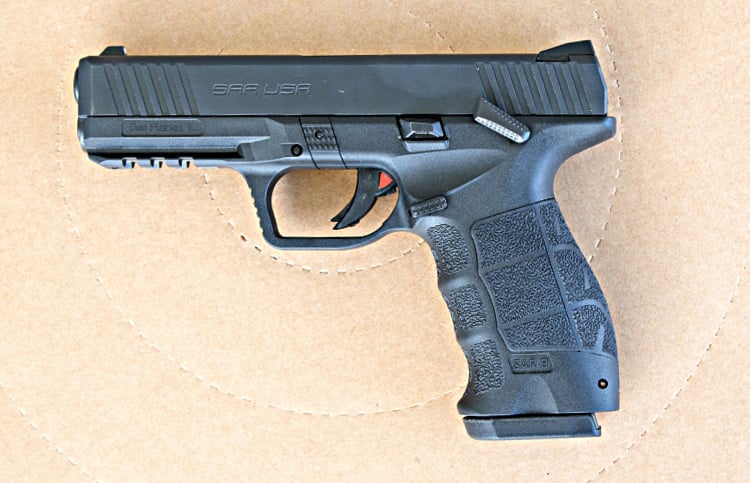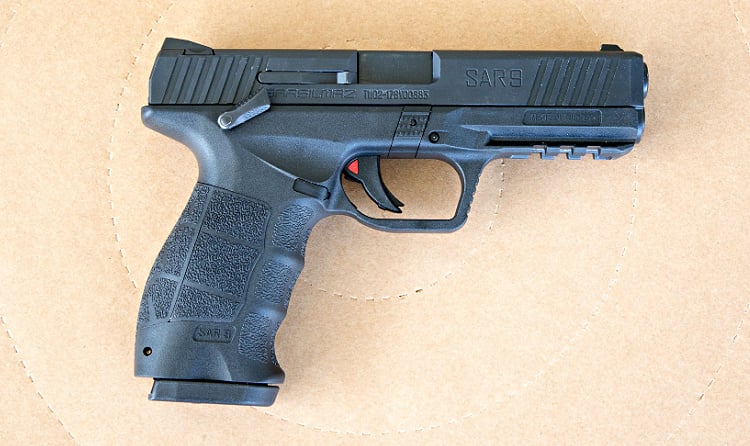For some time now, some pretty nifty firearms have been coming to the US out of Turkey, including some very decent handguns. Now they are joined by the SAR 9 pistol manufactured by Sarsilmaz and imported by SAR USA.
This article originally ran in November of 2017.


First Glance
When the test sample came out of the box at the receiving FFL, ProArms Gun Shop in Live Oak, Florida, the first to examine it were staffers Ray Millican and Allen Davis, the general manager. “Turkish gun-makers seem to copy freely,” observed Allen, a retired lawman and champion shooter. “Looks an awful lot like a Glock on top….”


“And an HK on the bottom, judging by the grip insert treatment” finished Ray, a retired Special Forces Command Sergeant Major. About all I could add to that was that the SAR9 had just a touch of M1911 DNA too, in the form of a safety that worked for a shooter much the same as John Browning’s masterpiece.

The magazines (it came with two) are all steel. Oddly enough, though the witness holes in the back of the mags only go to “15,” the magazines held seventeen rounds apiece. The last round or so did take some persuasion to get under the feed lips.
As is currently in fashion in the American market, the SAR 9 has an accessory rail, and also well-designed slide grasping grooves both fore and aft on the slide. Your reviewer is not a fan of front grasping grooves, but that is of course subjective.

The caliber is 9mm Luger, barrel length is 4.4”, and unloaded weight is 27.1 ounces. Its fixed sights are all steel, the rear dovetailed in, and come with three white dots. The suggested MSRP is $449, but one in-the-know source expects that its out the door price before taxes will probably come down to around $399.
In the Hand
The homage to Heckler and Koch in the grip treatment was splendidly executed, with a palm-filling swell in just the right place and a trigger reach that put the index finger of my “average size adult male hand” almost perfectly at what I consider the sweet spot for leverage, the distal joint.


The trigger design is more Glock-like than the pull. There is less take-up than a Glock as the pull begins, but more “roll” between firm trigger resistance and the shot. There is little if any “backlash,” or trigger movement after the sear releases. I used a Lyman digital trigger gauge to measure pull weight, once at the toe of the trigger which seems to be the industry standard, and once again at the center of the trigger where the shooter’s finger most often comes to rest. The latter, I think, is the measurement most relevant to the shooter.

At the toe, the pull weight averaged 4.98 pounds, but at the center it went up to an average of 7.13 pounds. That’s a bit more increase than I usually see between the two trigger contact points, but such are the variations in trigger system geometry. That said, in the hand the pull didn’t feel heavy at all. That may have been partly due to being able to get more finger on the trigger due to the SAR9’s shooter-friendly trigger reach dimension.
Shooting the SAR 9
The first thing I noticed when I started shooting the SAR9 was that it had been sighted in for point of aim/point of impact at the factory. Any gun writer can tell you that this is not exactly the norm in the industry, which is why most of us keep dovetailed sight pushers on hand. The SAR9 had scored a positive point with me out of the starting gate.



My accuracy protocol is to test from a Caldwell Matrix rest on a concrete bench at a measured 25 yards. Each group is measured twice, once for all five to get an idea of what an experienced shooter can do with the gun as steady as human hands can make happen, and again for the best three hits in the group.
Experience and research alike (see American Handgunner magazine, March/April 2002) have shown me that this will roughly duplicate what the same gun and load will deliver for all five from a machine rest; dropping the worst two seems to factor out unnoticed human error. Measurements were taken center to center between the farthest bullet holes examined, to the nearest 0.05”.
I try to test a handgun with the three most popular bullet weights in its caliber. The SAR9 being chambered for 9mm Luger, a/k/a 9X19 and 9mm NATO, that meant 147, 124, and 115 grain. For each, I used ammo that has earned a reputation for accuracy.

The 147 grain is more popular in North America than anywhere else in the world. Here, I used Winchester WinClean with jacketed truncated cone bullet, the most accurate low-lead 9mm practice round I’ve worked with yet, and one I’ve seen win numerous matches. The five-shot group went 2.55”, and the best three were well under one inch at 0.85”.

124 grain, once the heaviest commercially available in this caliber, for the last three decades has been the popular “middleweight” 9mm. I chose SIG’s V-Crown jacketed hollow point, and it gave a 2.65” five-shot measurement with the best three still under an inch at 0.95”.

The 115-grain choice was Federal’s famous 9BP, an “old school” standard velocity jacketed hollow point that earned a better stopping record on the street than anything else of its kind, and was also chosen by great shooters like Tom Campbell for accuracy-intensive matches such as Bianchi Cup. With the SAR9, in punched five holes in 2.45”, with four of those in an inch and a half and the best t here in 1.30”.
This very consistent performance with all three bullet weights averaged out to 2.55” for five-shot groups, and 1.03” for best-three clusters. In a world where “four inches at 25 yards” is widely quoted as “acceptable service pistol accuracy,” I am more than happy with the accuracy of the SAR 9.
Loading and reloading went smooth and easy. Because that last round didn’t want to go into the magazine easily, I had feared the cartridge stack might have so little spring flexion left that it wouldn’t want to seat easily fully loaded with the slide forward. Happily, I was wrong: “combat reloads” with the slide forward were easy and positive with all seventeen rounds in the mag.
What did happen was that there was enough downward pressure to make the mag release button very hard to operate when removing a fully loaded magazine to unload the pistol. Happily, there’s a cure for this: push up slightly on the floorplate of the magazine while manipulating the mag release button with the firing hand, and the problem is solved.
I found the thumb safety a bit stiff to thumb down into the “fire” position, and very stiff to push back up to the “on safe” position. I thought at first it might be my arthritic old thumbs, but other testers with no such problems found the same issue. I had to shift hand position to on-safe one-handed.
SAR 9 In Action
For a benchmark for “shootability,” I like to run a test gun in a match or at least a qualification, but neither intersected with my schedule during the SAR9 test. To get a feel of it for shooting under time pressure, I figured a Glock course would be good for this Glock-ish pistol, and I went with the 50-shot GSSF Indoor Course (shot outdoors, in this case). Distances are 25 to 75 feet. I was all in the ten ring and clean on points out past the 15-yard line, but honked two shots low at 25 yards.

The next ring out from the “ten” is the “eight ring,” so that brought me down to 496 out of 500 possible points, and 39 out of 50 hits in the tie-breaking center “ten-X” ring, which is four inches in diameter. That’s ball park average for me on that course with my own familiar Glocks, so the performance with a different pistol was not at all unsatisfying.

Bottom Line
The first criterion is reliability, and our test SAR9 ran 100% in that regard, for hundreds of rounds. Recoil was mild as expected. It wouldn’t go into Kydex holsters for my standard size Glocks, but fit quite well in leather ones built for the Glock 21. A day of carry with the SAR9 in a Ted Blocker #5 Thumb-break showed it to be just as comfortable as carrying a Glock 17. (Big surprise, huh?)


feature.
All in all, I liked the SAR9, my only real complaint being the difficulty in manipulating the thumb safety. After the test, I’d sum it up like this:
The “sarnine” is a pistol from Turkey,
And if your finger ain’t jerky,
You’ll have lots of fun
With this affordable gun,
And you’ll find your scores getting perky.



Is it just me or has Massad Ayoob’s bio finally eclipsed the length of the actual article?
For quite some time now, I’ve been quite impressed with the Sarsilmaz line, already owning their CM-9 and B6P. Both pistols punch way above their ‘price class.’ Well, it looks like I may be adding another model to my stable. Gonna need a bigger safe soon!
De Oppresso Liber
I bought in all great reviews on this handgun I got my own SAR9T been big disappointment. The first thing I did when got home from gun store was take my SAR9T to my bedroom to field strip it. Yes read the manual how do that before try field stripping it. Here what happen after pull hard on take down levers witch require more force than what ever one else reviewing handgun has put up with they came right off the gun .It seem take down levers on SAR9T held in place buy polymer roll pin falls out the SAR9T witch disables the trigger if not put back in gun. So got polymer roll pin back in the gun levers back on gun pull down. So now come easy part make sure magazine out SAR9T pull slide back release it than pull trigger than slide should come right off gun. Well guess what the slide would come off frame after trying many times buy me and gun shop and gun smith work at the gun shop . I had send gun back SAR USA for repairs has even been shot. When get back I am selling for Glock 17 Gen 5 because Glock may not be perfect but they do not fall part when field strip they come part when field strip them.